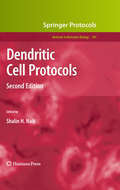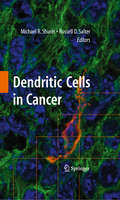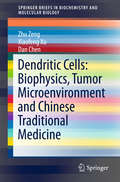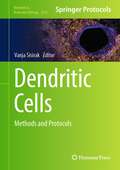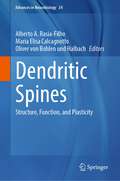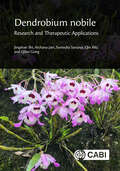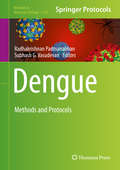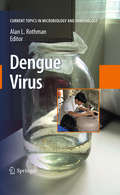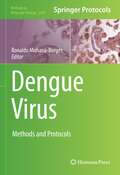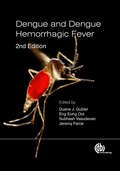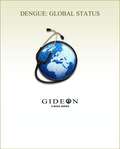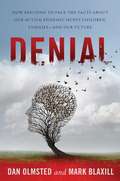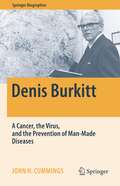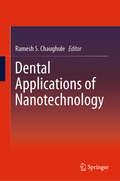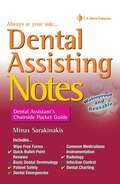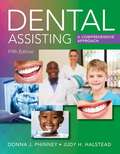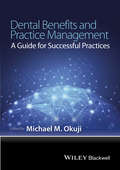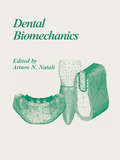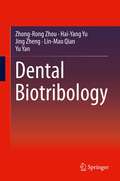- Table View
- List View
Dendritic Cell Protocols
by Shalin H. NaikGiven the vital importance of immune system research, the gathering of clear, consistent, and informative protocols involving the study of dendritic cells is paramount. Bringing the popular first edition fully up to date, Dendritic Cell Protocols, Second Edition presents protocols from experts in the field that cover the basics and more complex forays into the exploration of DC development and function, both in mice and humans. The first section of the volume involving humans explores topics such as the isolation of blood DC subtypes, primary skin Langerhans cells, and the generation of gene-manipulated human DCs with the inclusion of more clinically relevant methods as well, while the second section involving rodent models delves into DC and precursor generation in vitro, isolation ex vivo, disease models, as well as DC functions and properties. Written in the highly successful Methods in Molecular BiologyTM series style, chapters include introductions to their respective subjects, lists of the necessary materials and reagents, step-by-step, readily reproducible laboratory protocols, and notes on troubleshooting and avoiding known pitfalls. Comprehensive and cutting-edge, Dendritic Cell Protocols, Second Edition aims to become a bench-side handbook for both beginners and experts in the field of DC research and a long-term reference for some of the most popular methods put forward by those who lead the field.
Dendritic Cells in Cancer
by Russell D. Salter Michael R. ShurinIt covers all aspects of DC generation, function, survival and antitumor activity in the tumor environment both in vivo and in experimental in vitro systems. The goal in focusing on a spectrum of issues related to DC in cancer is to provide an extensive and expansive review rather than a collection of independent analyses from different authors. Specific topics to be covered include analysis of DC behavior in the tumor microenvironment, including endogenous and exogenous DC, multiple DC populations, molecular pathways responsible for DC dysfunction, tumor-derived factors altering DC polarization and activation, mechanisms of DC alterations, and the role of DC in tumor escape from immune recognition and elimination. Furthermore, additional chapters provide extensive analysis of the consequences of cancer therapy on the DC system and how aging impacts DC function in the tumor microenvironment. Finally, chapters are included examining strengths and pitfalls of current methodologies for generating DC from cancer patients for therapeutic purposes and on the role of tumor-mediated modulation of the DC system in cancer immunotherapy.
Dendritic Cells: Biophysics, Biomechanics, Mechanobiology and Tumor Microenvironment
by Zhu ZengThis book focuses on the fascinating topic of tumor microenvironment and dendritic cell immunotherapy. It provides readers with comprehensive insights into this field by offering detailed measurement protocols for assessing the biophysical characteristics of cells, along with bioinformatics analysis and mathematical modeling techniques to explore the initiation of dendritic cell-induced T cell immune responses within the tumor microenvironment. We also delve into the effects of chemical factors, mechanical stimulation, and traditional Chinese medicine on dendritic cells in this specific context. By delving into the intricate interactions between the tumor microenvironment and dendritic cells, readers will gain a profound understanding of tumor progression and the potential of dendritic cells as a therapeutic target. Moreover, the book presents novel perspectives that can pave the way for the development of innovative cancer treatment strategies.
Dendritic Cells: Biophysics, Tumor Microenvironment and Chinese Traditional Medicine
by Xiaofeng Xu Zhu Zeng Dan ChenIn this book, the authors discuss the biophysical characteristics of Dendritic cells (DCs) at various differentiation stages and in tumor microenvironments in detail. A type of Chinese traditional herb, which can improve the biophysical and microrheological properties of DCs, is also introduced. DCs are potent and specialized antigen-presenting cells that play a crucial role in initiating and amplifying both the innate and adaptive immune responses. The biophysical and microrheological characteristics of DCs are important for their motility and normal immune function. In tumor microenvironments, the motility and immune functions of DCs are impaired, but the mechanisms are largely unknown. This book offers researchers a comprehensive and deep insight into the biophysical characteristics of DCs and may also help to improve the efficiency of anti-tumor therapy based on DCs.
Dendritic Cells: Methods and Protocols (Methods in Molecular Biology #2618)
by Vanja SisirakThis detailed volume provides methods that can be used to study dendritic cell (DC) ontogeny, isolation, migration, and functions. After an introduction to murine and human DC subsets and their unique transcriptional, phenotypic, and functional properties, the book continues with sections covering in vivo studies, in vitro differentiation, enrichment, functional characterization, as well as Omics approaches to study dendritic cells. Written for the highly successful Methods in Molecular Biology series, chapters include introductions to their respective topics, lists of the necessary materials and reagents, step-by-step, readily reproducible laboratory protocols, and tips on troubleshooting and avoiding known pitfalls. Authoritative and practical, Dendritic Cells: Methods and Protocols is an ideal guide to familiarize readers with the current state of the art techniques to investigate these vital cells.
Dendritic Spines: Structure, Function, and Plasticity (Advances in Neurobiology #34)
by Alberto A. Rasia-Filho Maria Elisa Calcagnotto Oliver von Bohlen und HalbachThis reference provides detailed coverage of dendritic spines, the fascinating neuronal components that modulate synaptic transmission, development, strength, and plasticity and are involved in the function of multiple areas of the nervous system. The density, shape, and function of spines may indicate the cellular connectivity and synaptic plasticity in normal and pathological conditions. This field has undergone dramatic advances in terms of techniques and experimental findings from in vitro to in vivo data, from animal models to human neurons, and computational models using artificial intelligence. To address these cutting-edge findings, the book provides state-of-the-art, comprehensive coverage with chapters written by the leading international researchers in the field. The authors consider the multiple implications for the study of dendritic spines with broad implications in the neurosciences and related areas.
Dendrobium nobile: Research and Therapeutic Applications
by Professor Jingshan Shi Dr Archana Jain Dr Surendra Sarsaiya Professor Qin Wu Prof Qihai GongDendrobium nobile, a species of orchid native to South-east Asia, has been revered in traditional medicine systems for centuries due to its medicinal properties and therapeutic benefits. With a rich history in Chinese medicine and other traditional healing practices, there is now much interest in the chemical constituents of this orchid and potential applications for various health conditions. The aim of this book is to bridge the gap between the traditional knowledge surrounding this remarkable plant and the cutting-edge scientific investigations that have shed light on its pharmacological activities. It includes: · An overview of Dendrobium nobile, exploring its historical use in traditional medicine and its significance in various cultures. · Information on the chemical constituents, pharmacological activities, antioxidant properties and potential role in alleviating pain, inflammation, and respiratory diseases. · Therapeutic applications: immune enhancement, management of chronic conditions like diabetes and cardiovascular issues, gastrointestinal disorders, renal diseases, neuroprotection and skin health. · Safety and toxicity issues. · Sustainable practices and conservation of Dendrobium nobile, and the importance of preserving biodiversity.
Dengue
by Radhakrishnan Padmanabhan Subhash G. VasudevanInfection by flaviviruses such as dengue virus serotypes (DENV 1-4), Japanese encephalitis virus (JEV), tick-borne encephalitis virus (TBE), yellow fever virus (YFV) and West Nile virus (WNV) impact millions of lives and cause tens of thousands of mortalities each year. Dengue is a global public health emergency especially since there is no preventative vaccine or antiviral treatment for dengue disease. Dengue: Methods and Protocols offers the increasing number of dengue researchers a one-stop protocol book with techniques compiled from the leading laboratories working on dengue. Chapters cover topics such as dengue virus isolation from clinical samples, quantification of human antibodies against the virus, assays to quantify the virus particles, the widely used mouse model to study dengue pathogenesis, vaccine and antiviral efficacies. Written in the successful Methods in Molecular Biology series format, chapters include introductions to their respective topics, lists of the necessary materials and reagents, step-by-step, readily reproducible protocols and notes on troubleshooting and avoiding known pitfalls. Authoritative and easily accessible, Dengue: Methods and Protocols seeks to serve both professionals and novices with its well-honed methodologies on dengue research.
Dengue Virus
by Alan L. RothmanScientific research on dengue has a long and rich history. The literature has been touched by famous names in medicine- Benjamin Rush, Walter Reed, and Albert Sabin, to name a very few- and has been fertile ground for medical historians . The advances made in those early investigations are all the more remarkable for the limited tools available at the time. The demonstration of a viral etiology for dengue fever, the recognition of mosquitoes as the vector for transmission to humans, and the existence of multiple viral variants (serotypes) with only partial cross-protection were all accomplished prior to the ability to culture and characterize the etiologic agent. Research on dengue in this period was typically driven by circumstances. Epidemics of dengue created public health crises, although these were relatively short-lived in any one location, as the population of susceptible individuals quickly shrank. Military considerations became as a major driving force for research. With the introduction of large numbers of non-immune individuals into endemic areas, dengue could cripple military readiness, taking more soldiers out of action than hostile fire. Dengue and dengue hemorrhagic fever, which assumed pandemic proportions during the latter half of the last century, have shown no indication of slowing their growth during this first decade of the twenty-first century. Challenges remain in understanding the basic mechanisms of viral replication and disease pathogenesis, in clinical management of patients, and in control of dengue viral transmission. Nevertheless, new tools and insights have led to major recent scientific advances. As the first candidate vaccines enter large-scale efficacy trials, there is reason to hope that we may soon "turn the corner" on this disease.
Dengue Virus: Methods and Protocols (Methods in Molecular Biology #2409)
by Ronaldo Mohana-BorgesThis detailed volume explores various aspects of the dengue virus and its four serotypes (DENV1-4). Beginning with a section on protocols to produce DENV and its proteins that are fundamental for many biophysical, biochemical, immunological, and cellular studies, the book continues by covering protocols to study the interactions between DENV and cellular proteins, DENV immunopathogenesis and diagnosis, as well as recent advances in animal models that can be used in studies of DENV immunopathogenesis and vaccine development. Written for the highly successful Methods in Molecular Biology series, chapters include introductions to their respective topics, lists of the necessary materials and reagents, step-by-step, readily reproducible laboratory protocols, and tips on troubleshooting and avoiding known pitfalls. Authoritative and practical, Dengue Virus: Methods and Protocols serves as an ideal guide for researchers attempting to further understand this critical threat to worldwide public health.
Dengue and Dengue Hemorrhagic Fever
by Shannon Shannon Ana Fernandez-Sesma T T Nicholas Nicholas Christopher M Christopher M Katherine L Katherine L Goro Kuno George George Duane J Gubler Subhash Vasudevan Maria G Maria G Oliver Oliver Delia Delia Shelton S Shelton S Philippe Philippe Adolfo Adolfo Derek A Derek A T David M David M Keith J Keith J Aravinda M Aravinda M Eng Eong Ooi Mariano A Mariano A Michael D Michael D Katell Katell Jeremy Farrar Andrea V Andrea V Laura A Laura A Michael S Michael S Paul Paul Francesca D Francesca D Yara A Yara AContinued geographic expansion of dengue viruses and their mosquito vectors has seen the magnitude and frequency of epidemic dengue/dengue hemorrhagic fever (DF/DHF) increase dramatically. Recent exciting research on dengue has resulted in major advances in our understanding of all aspects of the biology of these viruses, and this updated second edition brings together leading research and clinical scientists to review dengue virus biology, epidemiology, entomology, therapeutics, vaccinology and clinical management.
Dengue and Dengue Hemorrhagic Fever
by Shannon Shannon Ana Fernandez-Sesma T T Nicholas Nicholas Christopher M Christopher M Katherine L Katherine L George George Maria G Maria G Oliver Oliver Delia Delia Shelton S Shelton S Philippe Philippe Adolfo Adolfo Derek A Derek A T David M David M Keith J Keith J Aravinda M Aravinda M Mariano A Mariano A Michael D Michael D Katell Katell Andrea V Andrea V Laura A Laura A Michael S Michael S Paul Paul Francesca D Francesca D Yara A Yara AContinued geographic expansion of dengue viruses and their mosquito vectors has seen the magnitude and frequency of epidemic dengue/dengue hemorrhagic fever (DF/DHF) increase dramatically. Recent exciting research on dengue has resulted in major advances in our understanding of all aspects of the biology of these viruses, and this updated second edition brings together leading research and clinical scientists to review dengue virus biology, epidemiology, entomology, therapeutics, vaccinology and clinical management.
Dengue and Zika: Control and Antiviral Treatment Strategies (Advances in Experimental Medicine and Biology #1062)
by Subhash G. Vasudevan Rolf HilgenfeldThis contributed volume contains 25 chapters from leading international scientists working on dengue and Zika viruses, who came together in Praia do Tofo in Mozambique to discuss the latest developments in the fields of epidemiology, pathogenesis, structural virology, immunology, antiviral drug discovery and development, vaccine efficacy, and mosquito control programs. The meeting venue offered an opportunity to discuss current research on these flaviviruses in an idyllic setting, and also to develop first-hand appreciation of the issues in infectious diseases facing developing countries and of the research gaps in Africa. For readers, who should include basic and clinical researchers in the field and public health professionals, the chapters are organized to provide a comprehensive overview of the various topics in current dengue and Zika virus research. A unique feature of the proceedings of this meeting is the inclusion of the discussions that took place following presentations. These have been transcribed and appended to the end of the relevant chapters, and they form the “salt in the soup” of this book.
Dengue: Global Status 2010 edition
by Dr Stephen Berger Gideon InformaticsDengue: Global Status is one in a series of GIDEON ebooks which summarize the status of individual infectious diseases, in every country of the world. Data are based on the GIDEON database (www.gideononline.com) which relies on standard text books, peer-review journals, Health Ministry reports and ProMED, supplemented by an ongoing search of the medical literature. Chapters are arranged alphabetically, by country name. Each section is divided into five subsections. 1. Descriptive epidemiology 2. Summary of clinical features 3. Global status of the disease 4. Status of the disease in a specific country 5. References
Denial: How Refusing to Face the Facts about Our Autism Epidemic Hurts Children, Families, and Our Future
by Dan Olmsted Mark BlaxillEven as the autism rate soars and the cost to our nation climbs well into the billions, a dangerous new idea is taking hold: There simply is no autism epidemic.The question is stark: Is autism ancient, a genetic variation that demands acceptance and celebration? Or is it new and disabling, triggered by something in the environment that is damaging more children every day?Authors Mark Blaxill and Dan Olmsted believe autism is new, that the real rate is rising dramatically, and that those affected are injured and disabled, not merely “neurodiverse.” They call the refusal to acknowledge this reality Autism Epidemic Denial. This epidemic denial blocks the urgent need to confront and stop the epidemic and endangers our kids, our country, and our future.The key to stopping the epidemic, they say, is to stop lying about its history and start asking "who profits?" People who deny that autism is new have self-interested motives, such as ending research that might pinpoint responsibility—and, most threateningly, liability for this man-made epidemic.Using ground-breaking research, the authors definitively debunk best-selling claims that autism is nothing new—and nothing to worry about.
Denis Burkitt: A Cancer, the Virus, and the Prevention of Man-Made Diseases (Springer Biographies)
by John H. CummingsThis biography of Dr. Denis Parsons Burkitt, after whom the childhood cancer Burkitt's lymphoma was named, and who was a pioneer of the dietary fiber movement, paints a personal but holistic portrait of both the man and his life's work. Featuring excerpts from Dr. Burkitt's personal diaries, spanning seven decades from his boyhood to just before his passing, and extensive family archives, this book invites readers to follow Burkitt's journey through life and experience his tribulations and successes. Prof. John Cummings was a colleague of Dr. Burkitt and weaves the tale of his life through the lens of family, faith, and science. The journey takes Burkitt from his childhood in Ireland, a country undergoing major social upheaval, through his medical studies in Dublin, to army service in Africa in the midst of WWII and the independence movements that swept the continent in the following years. During his two decades spent in Uganda, working for the Colonial Medical Service, Burkitt made his first major contribution to cancer research - the characterization of Burkitt's lymphoma and its possible viral cause. Following his return to England in 1966, he turned his attention to the cause of ‘Western Diseases’ especially the role of dietary fibre in the prevention of disease and promotion of health. This earned him even wider international recognition and helped to inspire what is a vital field of research today. The book examines Burkitt's personal views of the world around him, including his experiences as a committed evangelical Christian who had been raised an Irish Protestant, and the challenges, both familial and cultural, that this elicited from and towards him and his scientific work. The lymphoma and later the fibre story propelled Denis into an orbit of worldwide travel, fame and many honours. An engaging speaker but man of great humility, always giving the credit for much of what he did to others, he left a legacy of evidence and ideas for the causes of cancer and prevention of disease from which we all now benefit.
Dennen's Forceps Deliveries, Fourth Edition
by American College of Obstetricians and GynecologistsACOG has revived a classic with the fourth edition of Dennen's Forceps Deliveries. This volume retains much of the original text, including explanations of forceps devices and technique. It also provides the latest related ACOG guidelines, a chapter on vacuum assisted deliveries, and information on the current and changing status of forceps deliveries
Dental Applications of Nanotechnology
by Ramesh S. ChaughuleThis book discusses current trends and potential areas of nanotechnology applications in dental materials. Dentistry is undergoing yet another change to benefit mankind via the discipline of nanodentistry. A variety of nanostructures such as nanorobots, nanospheres, nanofibers, nanorods, etc., have been studied for various applications in dentistry and medicine. Preventive dentistry has also utilized nanodentistry to develop the nanomaterials for inclusion in a variety of oral health-care products. Methods to prevent and combat dental problems have been devised, discussed, and implemented since ancient times; however, there is a constant need for improved tools and techniques. This book is relevant academically for undergraduate and post-graduate dental students, dental practitioners, researchers, and faculties of dental universities, as this book explores the application of various nanobiomaterials in dentistry, discusses current research in dental nanomaterials and potential future areas of interest, and examines the use of nanotechnology in various fields of dentistry.
Dental Assisting Notes: Dental Assistant's Chairside Pocket Guide
by Minas SarakinakisA DAVIS’S NOTES BOOK! Rely on this handy pocket guide to quickly reference the must-know information you need to prepare for the everyday encounters you’ll face in clinical and practice. From easy-to-scan charts of the teeth and detailed depictions of dental instruments to helpful tips on how to administer oxygen and assist patients with multiple medical conditions, this comprehensive, chairside guide is the perfect companion for any setting. Write on/wipe off, waterproof pages make it easy to take notes and then disinfect the pages according to infection control standards.
Dental Assisting: A Comprehensive Approach
by Donna J. Phinney Judy H. HalsteadWelcome to the Fourth Edition of an established, widely utilized, and reliable resource in dental assisting! As a dental assistant, you will be expected to take on an increasing number of clinical and administrative responsibilities to stay competitive. DENTAL ASSISTING: A COMPREHENSIVE APPROACH delivers inclusive coverage of the basic and advanced clinical skills you need to master. This complete learning system includes the most current information on leading dental practices/procedures, equipment, and patient safety standards, as well as, incorporates animation, video, step-by-step photo illustrations, real-life case studies, and dynamic review materials. Quite simply, this best-seller is a trusted resource for any dental assistant preparing for a successful career in the field.
Dental Assisting: A Comprehensive Approach (Mindtap Course List Ser.)
by Donna J. Phinney Judy H. HalsteadPopular and trusted, DENTAL ASSISTING: A COMPREHENSIVE APPROACH, 5th Edition is the all-in-one resource that helps aspiring dental assistants break into the field with confidence. Dental assistants need to master many skills while taking on increasing responsibilities, from basic practices and procedures to advanced clinical competencies and patient safety -- and this book covers it all! A complete learning system, it offers many features that help you navigate the dental office while thinking on your feet, including case studies, animations, step-by-step instruction Also available, digital learning tools from MindTap leverage videos, real-life case studies, dynamic review materials, apps, and more, to help you learn on your own terms. Begin your future in dental assisting today!
Dental Assisting: A Comprehensive Approach (Mindtap Course List Series)
by Donna J. Phinney Judy H. HalsteadNIMAC-sourced textbook
Dental Benefits and Practice Management
by Michael M. OkujiDental Benefits and Practice Management: A Guide for Successful Practices is a practical tool that helps you manage your office in tune with the realities of modern dental practice. Written by both dentists and insurance industry professionals Practical explanations to effectively and legally process claims Describes the changes in dental practice management to make your practice patient centered Competitive strategies for dentists and organizations
Dental Biomechanics
by Arturo N NataliDental Biomechanics provides a comprehensive, timely, and wide-reaching survey of the relevant aspects of biomechanical investigation within the dental field. Leading the reader through the mechanical analysis of dental problems in dental implants, orthodontics, and natural tooth mechanics, this book covers an increasingly important and popular sub
Dental Biotribology
by Jing Zheng Hai-Yang Yu Lin-Mao Qian Yu Yan Zhong-Rong ZhouDental Biotribology summarizes the latest achievements in dental wear and is designed to help the reader better understand the relationship between structures and tribological properties of human teeth. This book provides guidance on the biomimic design of anti-wear engineering systems based on human teeth and also explains mechanisms of occlusal wear and erosion as well as fretting wear related to dental implants and orthodontics. Additionally, this book provides valuable insights into the development of improved dental materials and oral treatments.
